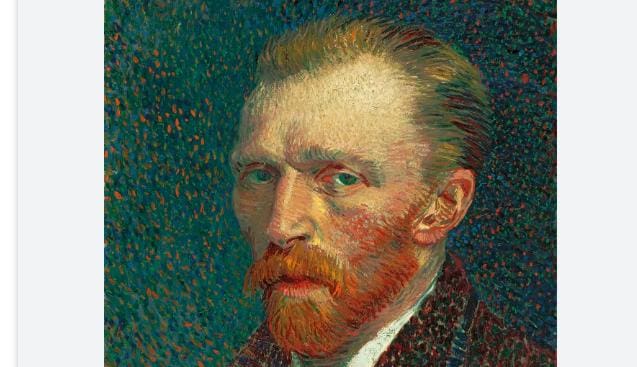Vincent van Gogh (1853-1890) was a Dutch post-impressionist painter who is widely considered one of the most influential figures in Western art history. He is renowned for his unique style, emotional use of color, and expressive brushwork. Despite struggling with mental health issues throughout his life, van Gogh created an extensive body of work, including over 2,100 artworks, consisting of paintings, drawings, and sketches. Some of his most famous and iconic works include “Starry Night,” “Sunflowers,” and “The Bedroom.” Van Gogh’s artistry and his tragic life have made him a celebrated and highly regarded artist, leaving a lasting impact on the art world.
25 fascinating facts about Vincent van Gogh:
- Vincent van Gogh was born on March 30, 1853, in the Netherlands.
- Despite being known as a painter, van Gogh initially pursued various professions including art dealing and teaching.
- He only started painting seriously in his late twenties.
- Van Gogh’s art style evolved from dark, somber tones to bold, vibrant colors and expressive brushwork.
- During his lifetime, van Gogh only sold one painting, “The Red Vineyard.”
- Van Gogh’s mental health greatly influenced his art, and he struggled with depression and anxiety throughout his life.
- The famous story of van Gogh cutting off his own ear is based on a letter he wrote to his friend, Paul Gauguin. The exact circumstances surrounding the incident remain somewhat unclear.
- Van Gogh spent time in psychiatric hospitals, including the Saint-Paul-de-Mausole asylum in Saint-Rémy-de-Provence, where he created some of his most famous works.
- He had a close and supportive relationship with his younger brother, Theo van Gogh, who financially supported him and played a significant role in promoting his art.
- Van Gogh was a prolific letter writer, and over 800 of his letters have been preserved. These letters provide insight into his thoughts, artistic processes, and personal struggles.
- He had a deep admiration for Japanese art and was influenced by its style and subject matter.
- Van Gogh formed friendships with other notable artists of his time, including Paul Gauguin and Émile Bernard.
- He experienced periods of intense productivity, creating multiple paintings in a single day.
- Van Gogh’s work was largely unrecognized during his lifetime, and he only gained significant posthumous recognition.
- Vincent van Gogh tragically died by suicide on July 29, 1890, at the age of 37.
- Van Gogh’s famous painting “The Starry Night” was created during his time at the Saint-Paul-de-Mausole asylum in 1889.
- He had a complex relationship with his family, particularly with his father, who disapproved of his artistic pursuits.
- Van Gogh was deeply inspired by the works of other artists, including Jean-François Millet, Rembrandt van Rijn, and Eugène Delacroix.
- He experimented with different artistic techniques, such as impasto (thick application of paint) and pointillism (the use of small dots or strokes of color).
- Van Gogh’s “Sunflowers” series, consisting of several still-life paintings, is among his most famous and recognizable works.
- The majority of van Gogh’s paintings were completed in the last two years of his life.
- Despite his troubled mental state, van Gogh was known for his kindness and compassion towards others.
- His artworks had a significant influence on subsequent art movements, including expressionism and fauvism.
- Van Gogh’s works have fetched record-breaking prices at art auctions, with one of his paintings, “Portrait of Dr. Gachet,” selling for $82.5 million in 1990.
- Today, Vincent van Gogh is regarded as one of the most influential artists in history, and his paintings continue to captivate and inspire people worldwide.
Here are some Vincent van Gogh paintings with brief descriptions:
- The Starry Night (1889): A mesmerizing night sky filled with swirling stars and a crescent moon over a tranquil village with a cypress tree dominating the foreground.
- Sunflowers (1888): A series of vibrant still-life paintings featuring sunflowers in various stages of bloom, showcasing van Gogh’s masterful use of color and texture.
- Irises (1889): A striking depiction of irises in a field, painted with vivid blues, purples, and greens, showcasing van Gogh’s ability to convey emotion through color.
- Café Terrace at Night (1888): An atmospheric nighttime scene of a café illuminated by warm, golden light, with people seated at tables and the starry sky overhead.
- Wheatfield with Crows (1890): A powerful and ominous landscape painting featuring a vast wheatfield under stormy skies, with a flock of crows soaring above.
- The Bedroom (1888): A depiction of van Gogh’s own bedroom, characterized by bold colors and simplified shapes, capturing a sense of intimacy and personal space.
- Portrait of Dr. Gachet (1890): A sensitive portrait of Dr. Gachet, one of van Gogh’s physicians, capturing the doctor’s melancholic expression and reflecting van Gogh’s own emotional state.
- Self-Portrait with Bandaged Ear (1889): A self-portrait painted after van Gogh famously cut off a portion of his ear, reflecting his personal turmoil and psychological distress.
- Almond Blossoms (1890): A series of paintings depicting delicate almond blossoms against a clear blue sky, symbolizing new life and hope.
- The Potato Eaters (1885): A somber portrayal of peasants gathered around a table, lit by a single lamp, conveying the hardships of rural life and the dignity of the working class.

